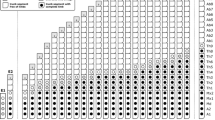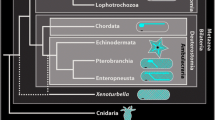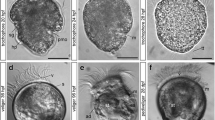Abstract
Nervous system development in echinoderms has been well documented, especially for sea urchins and starfish. However, that of crinoids, the most basal group of extant echinoderms, has been poorly studied due to difficulties in obtaining their larvae. In this paper, we report nervous system development from two species of crinoids, from hatching to late doliolaria larvae in the sea lily Metacrinus rotundus and from hatching to cystidean stages after settlement in the feather star Oxycomanthus japonicus. The two species showed a similar larval nervous system pattern with an extensive anterior larval ganglion. The ganglion was similar to that in sea urchins which is generally regarded as derived. In contrast with other echinoderm and hemichordate larvae, synaptotagmin antibody 1E11 failed to reveal ciliary band nerve tracts. Basiepithelial nerve cells formed a net-like structure in the M. rotundus doliolaria larvae. In O. japonicus, the larval ganglion was still present 1 day after settlement when the adult nervous system began to appear inside the crown. Stalk nerves originated from the crown and extended down the stalk, but had no connections with the remaining larval ganglion at the base of the stalk. The larval nervous system was not incorporated into the adult nervous system, and the larval ganglion later disappeared. The aboral nerve center, the dominant nervous system in adult crinoids, was formed at the early cystidean stage, considerably earlier than previously suggested. Through comparisons with nervous system development in other ambulacraria, we suggest the possible nervous system development pattern of the echinoderm ancestor and provide new implications on the evolutionary history of echinoderm life cycles.






Similar content being viewed by others
References
Amemiya S, Oji T (1992) Regeneration in sea lilies. Nature 357:546–547
Beer AJ, Moss C, Thorndyke M (2001) Development of serotonin-like and SALMFamide-like immunoreactivity in the nervous system of the sea urchin Psammechinus miliaris. Biol Bull 200:268–280
Bishop CD, Burke RD (2007) Ontogeny of the holothurian larval nervous system: evolution of larval forms. Dev Genes Evol 217:585–592
Bohn JM, Heinzeller T (1999) Morphology of the bourgueticrinid and isocrinid aboral nervous system and its possible phylogenetic implications (Echinodemata, Crinoidea). Acta Zool 80:241–249
Breimer A (1978) Recent crinoids. In: Moore RC, Teichert C (eds) Treatise on invertebrate paleontology, part T (Echinodermata 2). Geological Society of America and University of Kansas, Colorado and Kansas, pp 9–58
Breimer A, Lane NG (1978) Ecology and paleoecology. In: Moore RC, Teichert C (eds) Treatise on invertebrate paleontology, part T (Echinodermata 2). Geological Society of America and University of Kansas, Colorado and Kansas, pp 316–347
Burke RD (1983) Neural control of metamorphosis in Dendraster excentricus. Biol Bull 164:176–188
Burke RD, Osborne L, Wang D, Murabe N, Yaguchi S, Nakajima Y (2006) Neuron-specific expression of a synaptotagmin gene in the sea urchin Strongylocentrotus purpuratus. J Comp Neurol 496:244–251
Byrne M, Cisternas P (2002) Development and distribution of the peptidergic system in larval and adult Patiriella: comparison of sea star bilateral and radial nervous systems. J Comp Neurol 451:101–114
Byrne M, Nakajima Y, Chee FC, Burke RD (2007) Apical organs in echinoderm larvae: insights into larval evolution in the Ambulacraria. Evol Dev 9:432–445
Chia FS, Burke RD, Koss R, Mladenov PV, Rumrill SS (1986) Fine structure of the doliolaria larva of the feather star Florometra serratissima (Echinodermata: Crinoidea), with special emphasis on the nervous system. J Morphol 189:99–120
Cohen BL, Ameziane-Cominardi N, Eleaume M, de Forges BR (2004) Crinoid phylogeny: a preliminary analysis (Echinodermata: Crinoidea). Mar Biol 144:605–617
Dupont S, Thorndyke W, Thorndyke MC, Burke RD (2009) Neural development of the brittlestar Amphiura filiformis. Dev Genes Evol 219:159–166
Foote M (1999) Morphological diversity in the evolutionary radiation of Paleozoic and post-Paleozoic crinoids. Paleobiology 25(Suppl 2):1–115
Garstang W (1894) Preliminary note on a new theory of the phylogeny of the Chordata. Zool Anz 17:122–125
Hara Y, Yamaguchi M, Akasaka K, Nakano H, Nonaka M, Amemiya S (2006) Expression patterns of Hox genes in larvae of the sea lily Metacrinus rotundus. Dev Genes Evol 216:797–809
Heinzeller T (1998) The nervous system of crinoids: survey and taxonomic implications. In: Rich M, Telford M (eds) Echinoderms: San Francisco: Proceedings of the ninth International Echinoderm Conference, San Francisco/California/USA/5–9 August 1996. Balkema, Rotterdam, pp 169–174
Heinzeller T, Welsch U (1994) Crinoidea. In: Harrison FW, Chia FS (eds) Microscopic anatomy of invertebrates. Echinodermata, vol 14. Wiley-Liss, New York, pp 9–148
Hirokawa T, Komatsu M, Nakajima Y (2008) Development of the nervous system in the brittle star Amphipholis kochii. Dev Genes Evol 218:15–21
Holland ND (1991) Echinodermata: Crinoidea. In: Giese AC, Pearse JS, Pearse VB (eds) Reproduction of marine invertebrates. Echinoderms and lophophorates, vol 4. Boxwood Press, Pacific Grove, pp 247–299
Hyman LH (1955) The invertebrates. Echinodermata the coelomate bilateria, vol 4. McGraw-Hill, New York
Janies D (2001) Phylogenetic relationships of extant echinoderm classes. Can J Zool 79:1232–1250
Kubota H (1988) Crinoidea. In: Dan K, Sekiguchi K, Andoh H, Watanabe H (eds) Development of invertebrates. Baifuukan, Tokyo, pp 332–338
Lacalli TC, West JE (1986) Ciliary band formation in the doliolaria larva of Florometra 1. The development of normal epithelial pattern. J Embryol Exp Morph 96:303–323
Lacalli TC, West JE (2000) The auricularia-to-doliolaria transformation in two aspidochirote holothurians, Holothuria mexicana and Stichopus californicus. Invertebr Biol 119:421–432
Lester S (1988) Settlement and metamorphosis of Rhabdopleura normani (Hemichordata: Pterobranchia). Acta Zool 69:111–120
Mashanov VS, Zueva OR, Heinzeller T, Ashchauer B, Dolmatov IY (2007) Developmental origin of the adult nervous system in a holothurian: an attempt to unravel the enigma of neurogenesis in echinoderms. Evol Dev 9:244–256
Nakajima Y, Humphreys T, Kaneko H, Tagawa K (2004a) Development and neural organization of the tornaria larvae of the Hawaiian hemichordate, Ptychodera flava. Zool Sci 21:69–78
Nakajima Y, Kaneko H, Murray G, Burke RD (2004b) Divergent patterns of neural development in larval echinoids and asteroids. Evol Dev 6:95–104
Nakano H, Hibino T, Oji T, Hara Y, Amemiya S (2003) Larval stages of a living sea lily (stalked crinoid echinoderm). Nature 421:158–160
Nakano H, Hibino T, Hara Y, Oji T, Amemiya S (2004a) Regrowth of the stalk of the sea lily, Metacrinus rotundus (Echinodermata: Crinoidea). J Exp Zool 301A:464–471
Nakano H, Hibino T, Hara Y, Oji T, Amemiya S (2004b) Development of the sea lily Metacrinus rotundus: comparisons with feather stars. In: Heinzeller T, Nebelsick JH (eds) Echinoderms: Munchen. Taylor & Francis Group, London, pp 41–44
Nakano H, Murabe N, Amemiya S, Nakajima Y (2006) Nervous system development of the sea cucumber Stichopus japonicus. Dev Biol 292:205–212
Nezlin LP, Prodnikov IM, Davydov PV (1991) Catecholaminergic neurons in the larval nervous system of starfishes during metamorphosis. Zhu Evol Biokh Fiziol 27:19–27
Nielsen C, Hay-Schmidt A (2007) Development of the enteropneust Ptychodera flava: ciliary bands and the nervous system. J Morphol 268:551–570
Nomaksteinsky M, Rottinger E, Dufour HD, Chettouh Z, Lowe CJ, Martindale MQ, Brunet JF (2009) Centralization of the deuterostome nervous system predates chordates. Curr Biol 19:1264–1269
Paul CRC, Smith AB (1984) The early radiation and phylogeny of echinoderms. Biol Rev 59:443–481
Przibram H (1901) Experimentelle studien uber regeneration. Archiv fur Entwickelungsmechanik 11:321–345
Scouras A, Smith MJ (2006) The complete mitochondrial genomes of the sea lily Gymnocrinus richeri and the feather star Phanogenia gracilis: signature nucleotide bias and unique nad4L gene rearrangement within crinoids. Mol Phylogenet Evol 39:323–334
Seelinger O (1892) Studien zur entwicklungsgeschte der Crinoiden. Zool Jahrb Abt Anat Ontog 6:161–444
Shibata TF, Sato A, Oji T, Akasaka K (2008) Development and growth of the feather star Oxycomanthus japonicus to sexual maturity. Zool Sci 25:1075–1083
Acknowledgments
We are grateful to Drs. Tomoko F. Shibata, Atsuko Sato, Naoki Kuzuno, Yuko Hara, Taku Hibino, and the staff of MMBS for their help in taking care of both adult and larval crinoids. We thank Drs. Tatsuo Oji, Hiroyuki Kaneko, and Michael C. Thorndyke for their useful suggestions and discussions. We thank Drs. Aiko Hirata and Hiroshi Nakagawa for their valuable instructions on SEM. H. N. was supported by the JSPS Research Fellowship for Young Scientists, HFSP Long-Term Fellowship and the Swedish Research Council.
Author information
Authors and Affiliations
Corresponding author
Additional information
Communicated by H. Nishida
Rights and permissions
About this article
Cite this article
Nakano, H., Nakajima, Y. & Amemiya, S. Nervous system development of two crinoid species, the sea lily Metacrinus rotundus and the feather star Oxycomanthus japonicus . Dev Genes Evol 219, 565–576 (2009). https://doi.org/10.1007/s00427-010-0317-5
Received:
Accepted:
Published:
Issue Date:
DOI: https://doi.org/10.1007/s00427-010-0317-5




